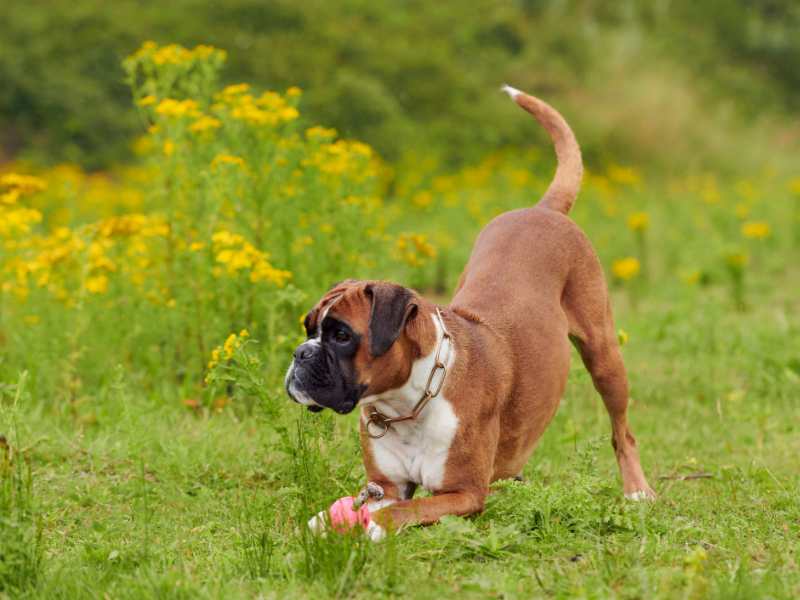Welcome to our complete guide on “Boxer Dog Weight Management.” In this guide, we’ll go into the important meanings of keeping a healthy weight for your loved Boxer dog.

Understanding how important weight management is for every Boxer owner. It directly affects their overall health, lifespan, and quality of life. In this starting section, we’ll give you an overview of why keeping your Boxer at a good weight is important and how it helps them.
So, whether you’ve owned Boxers for a long time or thinking about getting one, join us on this learning journey. Our goal is to make sure your furry friend enjoys a long, active, and happy life through proper weight care.
Understanding Boxer Body Condition 📏
Ideal Body Condition Score (BCS)
Body Condition Score (BCS) is a helpful method for checking a dog’s body fat and overall shape. For Boxers, this rating system is very important because it assists in assessing their weight and health. A healthy Boxer usually scores between 4-5 on a 1-9 scale or 2.5-3 on a 1-5 scale. This ideal number shows a Boxer with the right body balance. When feeling their sides, you’ll feel their ribs without seeing them.
Recognizing Underweight Boxers
It’s important to recognize an underweight Boxer for their well-being. Common signs include visible ribs, spine, and pelvic bones. An underweight Boxer looks too thin overall. Various factors can lead to being underweight, like not enough food, underlying issues, or parasites. Spotting the signs early lets you take measures to restore their health.
Identifying Overweight Boxers
It’s also key to identify overweight Boxers. Overweight Boxers show excessive body fat signs like no clear waistline, not easily feeling ribs, and appearing heavier than ideal. Obesity in Boxers can cause joint problems, heart disease, and a shorter life. So watching for these signs and addressing them through diet and exercise is crucial for their health.
Understanding and checking your Boxer’s body shape, whether under or overweight, allows you to properly care for their well-being and longevity. Regular vet visits provide useful insights into shape and condition to help make informed care choices.
Explore the Boxer Growth and Weight Chart: From Puppy to Adulthood. Ensure your Boxer’s healthy development with our comprehensive guide.
The Role of Nutrition 🥘

Choosing the Right Diet
Choosing the correct balanced diet for Boxers is very important for their overall health and well-being. When picking a diet, here are some key guidelines:
- High-Quality Commercial Dog Food: It’s essential to opt for high-quality store dog food specially made for Boxers. These formulas give the needed nutrients, vitamins, and minerals for wellness.
- Consultation with Your Veterinarian: Talk to your vet when selecting a diet. Vets offer expert advice based on factors like age, activity level or any issues. Their guidance ensures optimal health.
- Homemade Meals: If making homemade meals, it’s crucial to partner with a vet nutritionist. Professionals help craft balanced meals meeting all dietary requirements. Homemade can work if fully nutritious.
Feeding Frequency and Portion Control
Meal frequency and amounts are also key to good health and preventing overeating. Here are some recommendations:
- Boxer Puppy Feeding: Puppies should eat more, like three to four times per day. Gradually transition to two to three meals per day by 6-12 months old as needs change.
- Adult Boxer Feeding: Daily portions depend on height, weight, age and activity. It may range from one to six cups of dog food. For proper digestion, spread portions over multiple smaller meals daily.
Following these guidelines ensures a nutrition-rich diet catered to life stage and individual needs – promoting a long, healthy life.
Exercise and Activity Requirements 🏃♂️

Daily Exercise Needs
Boxers need regular exercise because they have high energy levels. Needs vary with age:
- 6-month-old: 20 min brisk walk daily
- Adults: 30-45 min walk daily. By 18-24 months, around 90 min daily exercise is typical.
Activities like walks, jogs, fetch and agility training meet their needs. Varied physical activity keeps them mentally and physically engaged.
Mental Stimulation
Boxers also benefit greatly from mental stimulation to prevent boredom and destructive behaviors.
Interactive toys and puzzle games are excellent ways to keep their minds busy. Toys encouraging problem-solving are fun and stimulating.
Regular training, like learning tricks or commands strengthens the bond and challenges intelligence. Incorporating obedience into their routine not only stimulates mentally but reinforces good behavior.
This holistic approach keeps Boxers happy, balanced and fulfilled through life by meeting physical and mental needs.
Unleash the best nutrition for your Boxer in 2023 with our top picks in ‘The Best Dog Food for Boxers 🐾‘ blog. Give your furry friend the fuel they need for a healthy and vibrant life!
Weight Management Plans 📈

Plan for Overweight Boxers
It’s important for a Boxer’s health to lose extra weight. Talk to the vet to set a realistic goal based on age, breed and activity level. Change food to one for weight loss and carefully measure portions. Limit treats high in calories.
Start exercise slowly with short walks and play. Keep track of weight loss in a journal. Make sure the Boxer drinks enough water and sees the vet regularly to check progress. Being patient and consistent is key, and celebrate wins along the way to a healthier pup.
Plan for Underweight Boxers
If a Boxer is underweight, help them gain in a healthy way. Discuss a proper goal with the vet considering age, breed and activity. Calculate daily calories needed to maintain plus 500-1000 extra for weight gain.
Make a balanced diet with fruits, veggies, lean protein and whole grains. Include fatty foods like nuts, peanut butter and olive oil to meet calorie targets. Do strength training exercises to build muscle mass.
Stay hydrated by drinking enough water. Keep a detailed food and exercise log and weight records. This helps make adjustments to stay on track.
Plan for Healthy Boxers
To keep a Boxer at a good weight takes balance:
Eat a diet balanced with fruits, veggies, lean protein and whole grains while limiting sugary, fatty and salty foods.
Monitor daily calories based on weight goals.
Exercise regularly with cardio, strength training and flexibility to maintain fitness and weight.
Weigh the Boxer often and record it to stay on target. Check with the vet if weight changes unexpectedly to discuss diet or exercise changes.
Following these plans can effectively manage a Boxer’s weight for overall health.
Checkups with the Vet 🏥

Keeping a Boxer at a good weight and healthy overall is an important part of caring for your pet. It requires routine checkups with the vet and talking to the vet before big diet or exercise changes. Boxers can have certain health problems common to the breed, and their traits and energy need consideration in weight plans.
Vets can offer helpful guidance about a Boxer’s health to make smart choices. Regular checkups review weight, overall health, and needs tied to weight. Finding issues early helps a Boxer much more.
Discover 10 Fun Facts About the Boxer Dog 🐾. Get to know these playful and loyal companions on a whole new level!
Conclusion
In conclusion, this Boxer Dog Weight Management Guide shows how important it is to provide good nutrition, exercise, and watchfulness to keep a Boxer healthy and fit. Boxers are known to be very playful and energetic, making routine exercise a must to prevent boredom issues. They are also smart and can learn well using fun methods. Boxers have large, powerful bodies, so managing their weight correctly is vital for their well-being.
To properly care for a Boxer’s weight, talking to the vet is key to set fair weight goals based on age, breed and activity level. Adjusting food to one for weight control and carefully measuring portions limits calories, as does cutting back on high-calorie snacks. Gradually including exercise like walks and play sheds excess pounds. Tracking progress and regular vet checkups monitors weight loss or gain over time.
As responsible owners, we have the duty and joy of ensuring a Boxer’s health. Being patient, consistent, and celebrating wins together leads to a fitter and happier pup. Remember that nutrition, exercise, and watchfulness together keep a Boxer in shape for life.
Check with the vet before big diet or exercise changes. They understand a dog’s individual needs and health to make sure plans are right. Vets also provide guidance on safe and effective strategies.
Vets help address the large pet obesity issue and advocate for all animals. Getting their input can make weight plans not just effective but safe as well.
Work closely with the vet to tailor a balanced plan for your Boxer including food, portions, routines and treats. Monitor weight regularly and be ready to adjust the plan as needed with vet guidance for the best results.
Partnering with a vet and being proactive supports a long and active life for a Boxer.
